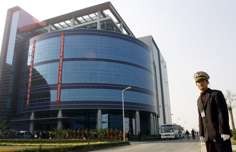China’s semiconductor ambitions get a reality check as Stats ChipPac deal sees poor returns

One of the first major acquisitions spurred by China’s aggressive policy to expand its semiconductor industry could turn into a financial albatross for some of the sector’s largest companies, according to analysts.
The deal in question is last year’s US$780 million buyout of semiconductor test and packaging giant Stats ChipPac by mainland rival Jiangsu Changjiang Electronics Technology (JCET), which was backed by Hong Kong-listed Semiconductor Manufacturing International Corp (SMIC) and the China IC Industry Fund.
“We find this merger has become an example that China should avoid in the future,” Bernstein senior analyst Mark Li said in a research note published on Monday.
“Recent performance shows no noticeable synergies from the merger of JCET and Stats ChipPac.”
Singapore-based Stats ChipPac is ranked fourth among the world’s largest outsourced semiconductor assembly and testing (OSAT) companies, which focus on the back end of the chip manufacturing process.
Sluggish global demand in smartphones, along with the lingering economic slowdown, has resulted in weak sales over the past few quarters for Stats ChipPac and other OSAT providers as handset manufacturers and contract chip makers bring more testing and packaging in-house, according to a report by Fitch Ratings.
Fitch predictedthis year’s revenue for Stats ChipPac will decline by 15 to 20 per cent because of the firm’s high exposure to advanced packaging for high-end smartphones. Stats ChipPac had posted revenue of US$244 million in the first quarter of this year, down 28 per cent from the previous quarter.
“Company financial reports indicate that the combined JCET and Stats ChipPac relative revenue market share among [the world’s] top five OSATs has not seen meaningful change since their
merger in the third quarter last year,” Li said.
“We also observe little evidence of better pricing or lower cost. Their combined gross margin has
been dropping in the recent quarters, mainly due to the drag by Stats ChipPac.”
Advanced Semiconductor Engineering, Amkor Technology and Siliconware Precision Industries are the three OSAT providers ranked ahead of JCET and Stats ChipPac.
“JCET is now burdened with the debt brought by Stats ChipPac and the additional leverage raised for the acquisition,” Li said.
Following the merger, JCET’s debt/equity ratio jumped to 2.3 per cent from 0.9 per cent before that transaction. The ratio indicates the proportion of debt used to finance a company’s assets relative to the amount of value represented in shareholders’ equity.
“JCET’s leverage has risen to an alarming level and its heavy interest burden is wiping out most of its operating profit,” Li said. “Its interest expense shot up from 50 million yuan (HK$58.32 million) each quarter to over 200 million yuan after the merger.”
He added that SMIC’s move in May to increase its stake in JCET may expose the contract chipmaker to the financial pressure brought by the merger.

That included a cash consideration of 2.65 billionyuan and the sale of SilTech’s 19.61 per cent interest in Stats ChipPac to JCET.
Li said SMIC will likely be more sensitive to JCET’s losses after boosting its equity position.
“Using JCET’s first-quarter results as an example, we estimate that ownership would reduce SMIC’s net profit [in the same period] by about five per cent,” he said.
SMIC posted a US$61.42 million net profit in the first quarter, up 10.7 per cent from US$55.48 million in the same period last year.
Unfazed by Stats ChipPac’s recent earnings, JCET has no plans to reduce its capital spending. It has earmarked, for example, US$300 million to more than double Stats ChipPac’s so-called fan-out wafer level packaging platform lines. The capacity upgrade is expected to generate US$100 million additional revenue per year for the combined JCET and Stats ChipPac operations.